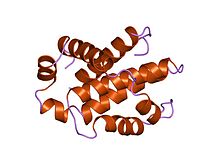| Apoptosis regulator proteins, Bcl-2 family | |||||||||
|---|---|---|---|---|---|---|---|---|---|
 Structure of human Bcl-xL, an inhibitor of programmed cell death.[1] | |||||||||
| Identifiers | |||||||||
| Symbol | Bcl-2 | ||||||||
| Pfam | PF00452 | ||||||||
| InterPro | IPR002475 | ||||||||
| SMART | SM00337 | ||||||||
| PROSITE | PDOC00829 | ||||||||
| SCOP2 | 1maz / SCOPe / SUPFAM | ||||||||
| OPM superfamily | 40 | ||||||||
| OPM protein | 2l5b | ||||||||
| Membranome | 232 | ||||||||
| |||||||||
The Bcl-2 family (TC# 1.A.21) consists of a number of evolutionarily-conserved proteins that share Bcl-2 homology (BH) domains. The Bcl-2 family is most notable for their regulation of apoptosis, a form of programmed cell death, at the mitochondrion.[2] The Bcl-2 family proteins consists of members that either promote or inhibit apoptosis, and control apoptosis by governing mitochondrial outer membrane permeabilization (MOMP), which is a key step in the intrinsic pathway of apoptosis. A total of 25 genes in the Bcl-2 family were identified by 2008.
Members of the BCL-2 family regulate apoptosis in mammals, reptiles, amphibs, fish, and other phyla of metazoan life, with exception of nematodes and insects.[3] Their molecular structure and function, as well as their protein dynamics, are highly conserved over hundreds of millions of years in tissue forming life forms.[4]
- ^ Muchmore SW, Sattler M, Liang H, et al. (May 1996). "X-ray and NMR structure of human Bcl-xL, an inhibitor of programmed cell death". Nature. 381 (6580): 335–41. Bibcode:1996Natur.381..335M. doi:10.1038/381335a0. hdl:10220/8302. PMID 8692274. S2CID 4279148.
- ^ Youle, Richard J.; Strasser, Andreas (2008). "The BCL-2 protein family: opposing activities that mediate cell death". Nature Reviews Molecular Cell Biology. 9 (1): 47–59. doi:10.1038/nrm2308. PMID 18097445. S2CID 7033834.
- ^ Banjara, Suresh; Suraweera, Chathura D.; Hinds, Mark G.; Kvansakul, Marc (12 January 2020). "The Bcl-2 Family: Ancient Origins, Conserved Structures, and Divergent Mechanisms". Biomolecules. 10 (1): 128. doi:10.3390/biom10010128. PMC 7022251. PMID 31940915.
- ^ Heckmeier, Philipp J.; Ruf, Jeannette; Rochereau, Charlotte; Hamm, Peter (February 27, 2024). "A billion years of evolution manifest in nanosecond protein dynamics". Proceedings of the National Academy of Sciences. 121 (10). arXiv:2309.06298. doi:10.1073/pnas.2318743121. PMID 38412135.